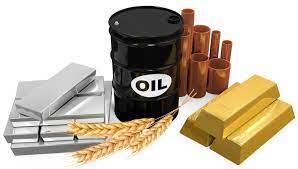In financial markets, commodities refer to physical goods or raw materials that are traded on exchanges or OTC markets. Commodities play a significant role in banks and financial markets, offering investors opportunities for speculation, hedging, and portfolio diversification. Here are some key aspects related to commodities in financial markets:
- Types of Commodities: Commodities can be broadly categorized into four main groups:a. Energy Commodities: These include crude oil, natural gas, gasoline, heating oil, and coal.b. Metals Commodities: Examples are gold, silver, platinum, copper, aluminum, and iron ore.c. Agricultural Commodities: These encompass crops like corn, wheat, soybeans, coffee, cocoa, sugar, and livestock such as cattle and hogs.d. Soft Commodities: Soft commodities refer to goods that are grown rather than extracted. They include items like cotton, lumber, rubber, and orange juice.
- Commodity Exchanges: Commodity exchanges serve as platforms for trading commodities. Well-known exchanges include the Chicago Mercantile Exchange (CME), New York Mercantile Exchange (NYMEX), London Metal Exchange (LME), and Intercontinental Exchange (ICE). These exchanges provide standardized contracts for different commodities, facilitating price discovery and trading.
- Futures Contracts: Futures contracts are commonly used to trade commodities. These contracts specify the delivery of a certain quantity of a commodity at a predetermined future date and price. Futures allow market participants to hedge against price fluctuations or speculate on the future direction of commodity prices.
- Spot Market: In addition to futures contracts, commodities can be traded in the spot market, where immediate delivery of the commodity takes place. Spot prices are determined by current supply and demand dynamics and can be influenced by factors like weather conditions, geopolitical events, and global economic trends.
- Commodity ETFs: Exchange-Traded Funds (ETFs) provide investors with exposure to commodity markets. Commodity ETFs usually hold futures contracts or physical commodities, allowing investors to gain price exposure without directly owning the underlying assets. These ETFs can track specific commodities or broader commodity indices.
- Price Influences: Commodities are influenced by various factors, including global supply and demand dynamics, geopolitical events, weather conditions, government policies, currency fluctuations, and global economic trends. For example, changes in oil prices can be influenced by political tensions in oil-producing regions, OPEC decisions, and global demand for energy.
- Commodity Trading Strategies: Investors and traders employ different strategies when trading commodities. Some common approaches include trend following, mean reversion, spread trading (taking advantage of price differentials between related commodities or delivery months), and options strategies for hedging or speculating on price movements.
- Commodity-Linked Derivatives: Derivative instruments linked to commodities include options, futures, swaps, and commodity-linked structured products. These instruments allow market participants to manage price risks, gain exposure to commodities, or speculate on price movements.
- Commodity Market Participants: Various participants operate in commodity markets, including producers, consumers, speculators, hedgers, and investors. Producers and consumers use commodity markets to manage price risks associated with their business operations. Speculators and investors seek to profit from price movements, while hedgers aim to protect against adverse price fluctuations.
- Commodities and Inflation: Commodities have historically exhibited a relationship with inflation. As inflation rises, commodity prices may increase due to higher production costs, increased demand, or currency depreciation. Investors sometimes allocate to commodities as a hedge against inflation.
It’s important to note that investing in commodities carries risks, including price volatility, market disruptions, geopolitical events, and regulatory changes. Investors should carefully assess their risk tolerance, conduct thorough research, and consider their investment objectives before participating in commodity markets.
SHARE
